Cross-talk between the p38alpha and JNK MAPK pathways mediated by MAP kinase phosphatase-1 determines cellular sensitivity to UV radiation
- PMID: 20547488
- PMCID: PMC2923983
- DOI: 10.1074/jbc.M110.117911
Cross-talk between the p38alpha and JNK MAPK pathways mediated by MAP kinase phosphatase-1 determines cellular sensitivity to UV radiation
Erratum in
- J Biol Chem. 2011 May 13;286(19):17398
Abstract
MAPK phosphatase-1 (DUSP1/MKP-1) is a mitogen and stress-inducible dual specificity protein phosphatase, which can inactivate all three major classes of MAPK in mammalian cells. DUSP1/MKP-1 is implicated in cellular protection against a variety of genotoxic insults including hydrogen peroxide, ionizing radiation, and cisplatin, but its role in the interplay between different MAPK pathways in determining cell death and survival is not fully understood. We have used pharmacological and genetic tools to demonstrate that DUSP1/MKP-1 is an essential non-redundant regulator of UV-induced cell death in mouse embryo fibroblasts (MEFs). The induction of DUSP1/MKP-1 mRNA and protein in response to UV radiation is mediated by activation of the p38alpha but not the JNK1 or JNK2 MAPK pathways. Furthermore, we identify MSK1 and -2 and their downstream effectors cAMP-response element-binding protein/ATF1 as mediators of UV-induced p38alpha-dependent DUSP1/MKP-1 transcription. Dusp1/Mkp-1 null MEFs display increased signaling through both the p38alpha and JNK MAPK pathways and are acutely sensitive to UV-induced apoptosis. This lethality is rescued by the reintroduction of wild-type DUSP1/MKP-1 and by a mutant of DUSP1/MKP-1, which is unable to bind to either p38alpha or ERK1/2, but retains full activity toward JNK. Importantly, whereas small interfering RNA-mediated knockdown of DUSP1/MKP-1 sensitizes wild-type MEFs to UV radiation, DUSP1/MKP-1 knockdown in MEFS lacking JNK1 and -2 does not result in increased cell death. Our results demonstrate that cross-talk between the p38alpha and JNK pathways mediated by induction of DUSP1/MKP-1 regulates the cellular response to UV radiation.
Figures
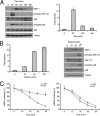
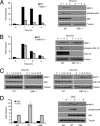

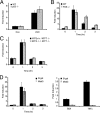
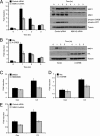
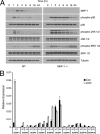

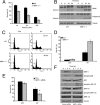

Similar articles
-
Essential role for mitogen-activated protein (MAP) kinase phosphatase-1 in stress-responsive MAP kinase and cell survival signaling.J Biol Chem. 2005 Apr 22;280(16):16461-6. doi: 10.1074/jbc.M501762200. Epub 2005 Feb 17. J Biol Chem. 2005. PMID: 15722358
-
Distinct binding determinants for ERK2/p38alpha and JNK map kinases mediate catalytic activation and substrate selectivity of map kinase phosphatase-1.J Biol Chem. 2001 May 11;276(19):16491-500. doi: 10.1074/jbc.M010966200. Epub 2001 Jan 30. J Biol Chem. 2001. PMID: 11278799
-
Cyclic AMP inhibits JNK activation by CREB-mediated induction of c-FLIP(L) and MKP-1, thereby antagonizing UV-induced apoptosis.Cell Death Differ. 2008 Oct;15(10):1654-62. doi: 10.1038/cdd.2008.87. Epub 2008 Jun 20. Cell Death Differ. 2008. PMID: 18566605
-
Mitogen-activated protein (MAP) kinase/MAP kinase phosphatase regulation: roles in cell growth, death, and cancer.Pharmacol Rev. 2008 Sep;60(3):261-310. doi: 10.1124/pr.107.00106. Pharmacol Rev. 2008. PMID: 18922965 Review.
-
Protecting the stress response, guarding the MKP-1 mRNA.Cell Cycle. 2008 Sep 1;7(17):2640-2. doi: 10.4161/cc.7.17.6534. Epub 2008 Sep 2. Cell Cycle. 2008. PMID: 18728392 Free PMC article. Review.
Cited by
-
p38 MAPK mediates calcium oxalate crystal-induced tight junction disruption in distal renal tubular epithelial cells.Sci Rep. 2013;3:1041. doi: 10.1038/srep01041. Epub 2013 Jan 9. Sci Rep. 2013. PMID: 23304432 Free PMC article.
-
Cell-type specificity of β-actin expression and its clinicopathological correlation in gastric adenocarcinoma.World J Gastroenterol. 2014 Sep 14;20(34):12202-11. doi: 10.3748/wjg.v20.i34.12202. World J Gastroenterol. 2014. PMID: 25232253 Free PMC article.
-
Ziram activates mitogen-activated protein kinases and decreases cytolytic protein levels in human natural killer cells.Toxicol Mech Methods. 2011 Oct;21(8):577-84. doi: 10.3109/15376516.2011.578170. Epub 2011 Aug 23. Toxicol Mech Methods. 2011. PMID: 21859362 Free PMC article.
-
P2X7 Nucleotide and EGF Receptors Exert Dual Modulation of the Dual-Specificity Phosphatase 6 (MKP-3) in Granule Neurons and Astrocytes, Contributing to Negative Feedback on ERK Signaling.Front Mol Neurosci. 2018 Jan 10;10:448. doi: 10.3389/fnmol.2017.00448. eCollection 2017. Front Mol Neurosci. 2018. PMID: 29375309 Free PMC article.
-
Irreversible JNK1-JUN inhibition by JNK-IN-8 sensitizes pancreatic cancer to 5-FU/FOLFOX chemotherapy.JCI Insight. 2020 Apr 23;5(8):e129905. doi: 10.1172/jci.insight.129905. JCI Insight. 2020. PMID: 32213714 Free PMC article.
References
-
- Dickinson R. J., Keyse S. M. (2006) J. Cell Sci. 119, 4607–4615 - PubMed
-
- Owens D. M., Keyse S. M. (2007) Oncogene 26, 3203–3213 - PubMed
-
- Chu Y., Solski P. A., Khosravi-Far R., Der C. J., Kelly K. (1996) J. Biol. Chem. 271, 6497–6501 - PubMed
-
- Slack D. N., Seternes O. M., Gabrielsen M., Keyse S. M. (2001) J. Biol. Chem. 276, 16491–16500 - PubMed
Publication types
MeSH terms
Substances
Grants and funding
LinkOut - more resources
Full Text Sources
Research Materials
Miscellaneous

